 Halloween is this week, and as the days grow shorter and the evening shadows lengthen, it’s time for a good ghost story. I’ve been a fan of them all my life. One of my earliest and scariest memories of Halloween is listening to the Disney album, “Chilling, Thrilling Sounds of the Haunted House.” We also had an old 45 single of “The Headless Horseman,” sung by Thurl Ravenscroft (the man who sings the songs on “The Grinch Who Stole Christmas” and the voice of Tony the Tiger). That song sung in Ravenscroft’s basso profundo was so scary to me I couldn’t even listen to it, and my brother Jeff played it over and over. I found it on iTunes not long ago and it’s still as scary as ever.
Halloween is this week, and as the days grow shorter and the evening shadows lengthen, it’s time for a good ghost story. I’ve been a fan of them all my life. One of my earliest and scariest memories of Halloween is listening to the Disney album, “Chilling, Thrilling Sounds of the Haunted House.” We also had an old 45 single of “The Headless Horseman,” sung by Thurl Ravenscroft (the man who sings the songs on “The Grinch Who Stole Christmas” and the voice of Tony the Tiger). That song sung in Ravenscroft’s basso profundo was so scary to me I couldn’t even listen to it, and my brother Jeff played it over and over. I found it on iTunes not long ago and it’s still as scary as ever.
To really get the feel of Halloween, however, there’s nothing quite like settling down on a dark night with a ghost story that scares the living bejeezus out of you, and I have several good suggestions.
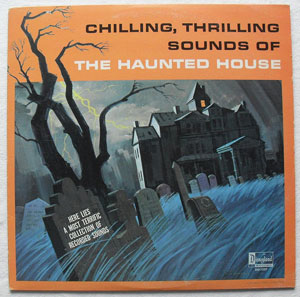 Since Horace Walpole published The Castle of Otranto in 1764, the horror novel has been wildly popular. The Mysteries of Udolpho (1794) made Ann Radcliffe the most popular novelist in England. In the twentieth century the horror novel came to be viewed as a cheap knockoff of serious fiction, nothing more than junk reading, undoubtedly because it became linked with Hollywood horror flicks. And while I’m a big fan of Abbott and Costello Meet Frankenstein (1948), there is a whole field of supernatural writing that predates Hollywood and Stephen King and that will make your hair stand on end.
Since Horace Walpole published The Castle of Otranto in 1764, the horror novel has been wildly popular. The Mysteries of Udolpho (1794) made Ann Radcliffe the most popular novelist in England. In the twentieth century the horror novel came to be viewed as a cheap knockoff of serious fiction, nothing more than junk reading, undoubtedly because it became linked with Hollywood horror flicks. And while I’m a big fan of Abbott and Costello Meet Frankenstein (1948), there is a whole field of supernatural writing that predates Hollywood and Stephen King and that will make your hair stand on end.
Everyone knows about Edgar Allan Poe, who practically invented the modern horror story when his Tales of the Grotesque and Arabesque was published in 1839, and Bram Stoker, whose Dracula (1897) defined for all time in literature and film the vampire genre. And if you haven’t read Stoker’s short story, “The Squaw,” you should.
We also know about the Headless Horseman (surging in popularity again thanks to the new Fox show, “Sleepy Hollow”) thanks to Washington Irving’s short story, “The Legend of Sleepy Hollow,” first published in 1820. Like all good writers of the ghost story, it’s all about setting the proper mood, which Irving did: “It was the very witching time of night that Ichabod, heavy-hearted and crestfallen, pursued his travel homewards along the sides of the lofty hills which rise above Tarry Town, and which he had traversed so cheerily in the afternoon. . .All the stories of ghosts and goblins that he had heard in the afternoon now came crowding upon his recollection. The night grew darker and darker; the stars seemed to sink deeper in the sky. . .he had never felt so lonely and dismal. He was, moreover, approaching the very place where many of the scenes of the ghost-stories had been laid.”
Besides its familiar tale of the no-noggin Hessian, Irving’s story contains one of the richest literary portraits of a golden Hudson Valley autumn you’ll ever read. If for no other reason, if you love fall, you’ll love reading or re-reading “The Legend of Sleepy Hollow.” [Comic Aside 1: Watch Andy Griffith repeatedly read the Washington Irving lines above to Opie in “A Wife for Andy,” episode 29 of season 3 of “The Andy Griffith Show.”]
So yes, read Poe, Stoker, and Irving. But now, please allow me to introduce you to some of the best of the genre of the classic ghost story, masters of the craft who aren’t so widely read today, but who should be.
 Start with the Irish writer Sheridan Le Fanu (1814-1873), the leading gothic writer of the nineteenth century. A contemporary of Poe, his stories are filled with gloomy castles, supernatural visitations, and descents into madness and suicide. You could do a lot worse than beginning with his short story, “Squire Toby’s Will” (1868), which sets the mood perfectly in the opening sentence: “Many persons accustomed to travel the old York and London road, in the days of the stagecoaches, will remember passing, in the afternoon, say, of an autumn day. . .a large black and white house…overgrown with grass and weeds…” You know this is going to be good, and it is, a classic complete with demon dogs, voices in the night, and spectral vengeance.
Start with the Irish writer Sheridan Le Fanu (1814-1873), the leading gothic writer of the nineteenth century. A contemporary of Poe, his stories are filled with gloomy castles, supernatural visitations, and descents into madness and suicide. You could do a lot worse than beginning with his short story, “Squire Toby’s Will” (1868), which sets the mood perfectly in the opening sentence: “Many persons accustomed to travel the old York and London road, in the days of the stagecoaches, will remember passing, in the afternoon, say, of an autumn day. . .a large black and white house…overgrown with grass and weeds…” You know this is going to be good, and it is, a classic complete with demon dogs, voices in the night, and spectral vengeance.
Le Fanu was a master of the craft, and he heavily influenced later writers of supernatural stories like M.R. James and Algernon Blackwood. For some of his longer work, check out Uncle Silas (1864) and The House by the Churchyard (1863). Many think his best work is In a Glass Darkly (1872), which contains the short story “Carmilla,” which popularized the theme of the female vampire.
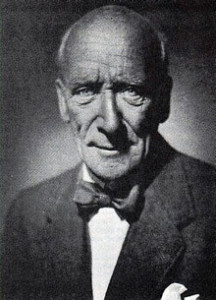 Next up is Algernon Blackwood (1869-1951), a prolific British writer who wrote a lot of great stories that now stand as classics in the field. H.P. Lovecraft, no slouch himself in this genre (read “The Dunwich Horror”), called Blackwood “the one absolute and unquestioned master of weird atmosphere.” The next time you find yourself alone on a cold, dark winter evening, with the rain and wind lashing the windowpanes, read his short story “The Wendigo” about a legendary creature that prowls the Canadian northwoods and stalks a hunting party: “This then was the party of four that found themselves in camp the last week of October. . .way up in the wilderness north of Rat Portage, a forsaken and desolate country.” His story “The Willows” is equally famous but in my humble opinion pales in comparison to “The Wendigo.”
Next up is Algernon Blackwood (1869-1951), a prolific British writer who wrote a lot of great stories that now stand as classics in the field. H.P. Lovecraft, no slouch himself in this genre (read “The Dunwich Horror”), called Blackwood “the one absolute and unquestioned master of weird atmosphere.” The next time you find yourself alone on a cold, dark winter evening, with the rain and wind lashing the windowpanes, read his short story “The Wendigo” about a legendary creature that prowls the Canadian northwoods and stalks a hunting party: “This then was the party of four that found themselves in camp the last week of October. . .way up in the wilderness north of Rat Portage, a forsaken and desolate country.” His story “The Willows” is equally famous but in my humble opinion pales in comparison to “The Wendigo.” 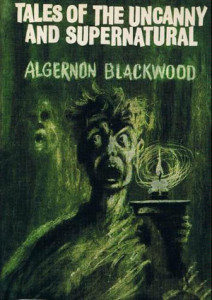 Start with these two and then check out any of the myriad of other ghost stories he wrote over the course of his 82 years, many of them collected in Tales of the Uncanny and the Supernatural (1949).
Start with these two and then check out any of the myriad of other ghost stories he wrote over the course of his 82 years, many of them collected in Tales of the Uncanny and the Supernatural (1949).
Le Fanu and Blackwood are superior storytellers, but the absolute master of this genre—again, in my opinion—is M.R. James. Montague Rhodes James (1862-1936) was a British medieval scholar and provost of King’s College, Cambridge, and of Eton College. If you’ve ever heard Andy Williams’ great Christmas song, “It’s the Most Wonderful Time of the Year,” you’ll recall the line about “there’ll be scary ghost stories and tales of the glories of Christmases long, long ago.” I always assumed that line referred to Dickens’s A Christmas Carol, but it harkens back to an English tradition in the Victorian era of telling ghost stories on Christmas Eve, a tradition personified by James. He wrote most of his ghost stories to be read aloud to his colleagues,  family, and friends on Christmas Eve. The stories were originally published in four books between 1904 and 1925, and they are unequalled in their perfection of the genre. He took the Gothic tales of the nineteenth century and modernized them, placing them in contemporary British society and updated them for a twentieth-century audience. [Comic Aside 2: “It’s the Most Wonderful Time of the Year” was co-written by George Wyle, who also co-wrote the “Gilligan’s Island” theme song]
family, and friends on Christmas Eve. The stories were originally published in four books between 1904 and 1925, and they are unequalled in their perfection of the genre. He took the Gothic tales of the nineteenth century and modernized them, placing them in contemporary British society and updated them for a twentieth-century audience. [Comic Aside 2: “It’s the Most Wonderful Time of the Year” was co-written by George Wyle, who also co-wrote the “Gilligan’s Island” theme song]
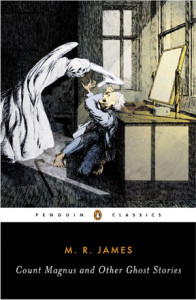 Thankfully for the modern reader, thirty-five of his stories have been gathered in two paperback volumes and re-published by Penguin Press, edited with introduction and notes by S.T. Joshi: Count Magnus and Other Ghost Stories: The Complete Ghost Stories of M.R. James, Volume 1, and The Haunted Dolls’ House and Other Ghost Stories: The Complete Ghost Stories of M.R. James, Volume 2. They’re worth every penny.
Thankfully for the modern reader, thirty-five of his stories have been gathered in two paperback volumes and re-published by Penguin Press, edited with introduction and notes by S.T. Joshi: Count Magnus and Other Ghost Stories: The Complete Ghost Stories of M.R. James, Volume 1, and The Haunted Dolls’ House and Other Ghost Stories: The Complete Ghost Stories of M.R. James, Volume 2. They’re worth every penny.
James was unparalleled in creating a mood that sets the perfect tone for his stories, almost all of which followed the same formula: the story is set in an English village, seaside town or country estate, an ancient town in Europe, or in old church institution or university; the protagonist is usually a reserved, bookish type, naïve and unassuming, who somehow manages to find themselves receiving several unwanted 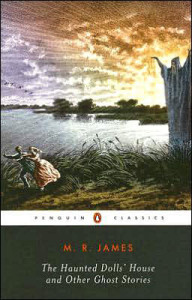 supernatural visitations from beyond the grave, often through the discovery of an old book, map, or manuscript. And while many of the stories take place in characteristically gloomy settings, James turned many of the traditional literary devices on their collective heads. The scariest parts of many stories—like “Rats”—take place in broad daylight, for instance.
supernatural visitations from beyond the grave, often through the discovery of an old book, map, or manuscript. And while many of the stories take place in characteristically gloomy settings, James turned many of the traditional literary devices on their collective heads. The scariest parts of many stories—like “Rats”—take place in broad daylight, for instance.
His most famous story is “Oh, Whistle and I’ll Come to You, My Lad,” but they are all scary and unsettling. This passage from “Casting the Runes” is typical: “He was in bed with the lights out . . .when he heard the unmistakable sound of his study door opening. . .no light was visible, no further sound came. . .he decided to lock himself in his room . . .he put his hand into the well-known nook under the pillow, only it did not get so far. What he touched was, according to his own account, a mouth with teeth, and with hair about it, and not the mouth of a human being. . .”
Le Fanu, Blackwood, and James are three nearly forgotten authors who are all worth reading, but no suggestion of good Halloween reading would be complete without a visit to the gloomy, haunted moors of Devon, in England’s West Country, where, as Sherlock Holmes said, the setting is a worthy one “if the devil did desire to have a hand in the affairs of men”:
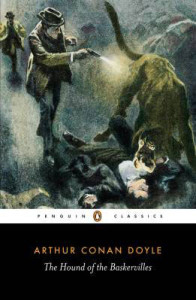 “But one false statement was made by Barrymore at the inquest. He said that there were no traces upon the ground round the body. He did not observe any. But I did—some little distance off, but fresh and clear.” “Footprints?” “Footprints.” “A man’s or a woman’s?” Dr. Mortimer looked strangely at us for an instant, and his voice sank almost to a whisper as he answered: “Mr. Holmes, they were the footprints of a gigantic hound!”
“But one false statement was made by Barrymore at the inquest. He said that there were no traces upon the ground round the body. He did not observe any. But I did—some little distance off, but fresh and clear.” “Footprints?” “Footprints.” “A man’s or a woman’s?” Dr. Mortimer looked strangely at us for an instant, and his voice sank almost to a whisper as he answered: “Mr. Holmes, they were the footprints of a gigantic hound!”
I first discovered Arthur Conan Doyle’s The Hound of the Baskervilles (1901-1902) when I was ten years old, and I have re-read it many times since. There are other masters of the macabre that will chill your blood on a dark night: W.W. Jacobs (most famously “The Monkey’s Paw”), Ambrose Bierce, and the aforementioned H.P. Lovecraft. Dip into these authors almost anywhere and you’ll be amply repaid, though you probably won’t sleep well.
A final note on how to get copies of all these stories: the advent of the Kindle and other electronic reading devices have made all these otherwise hard-to-find stories available at your fingertips. Some authors like Doyle are easily found in almost any bookstore, but others (beside the James books above) are long out of print—and out of copyright. For the latter reason, they are cheaply and widely available on your Kindle. You can get the complete works of Sheridan Le Fanu, for instance, for $2.99 on Kindle, and it downloads in minutes. I’m not advocating the e-book over the real thing (a subject for another blog entry), but one of the beauties of the Kindle is the ease with which one can find the complete works of some great authors and their otherwise scarce books for practically nothing.
Whether you read these authors on dark autumn nights or bright summer days, make their acquaintance. You will not be disappointed. You may then agree with John Milton that “millions of spiritual creatures walk the earth unseen, both when we wake and when we sleep.” Or they may leave you invoking the old Scottish prayer: “From ghoulies and ghosties and long-legged beasties, and things that go bump in the night, good Lord deliver us!” This autumn pull your chair closer to the fire, turn down the lamp, and turn the page. Did you hear that? I think there’s something out there.

Pingback: Autumn Reading | Off the Deaton Path